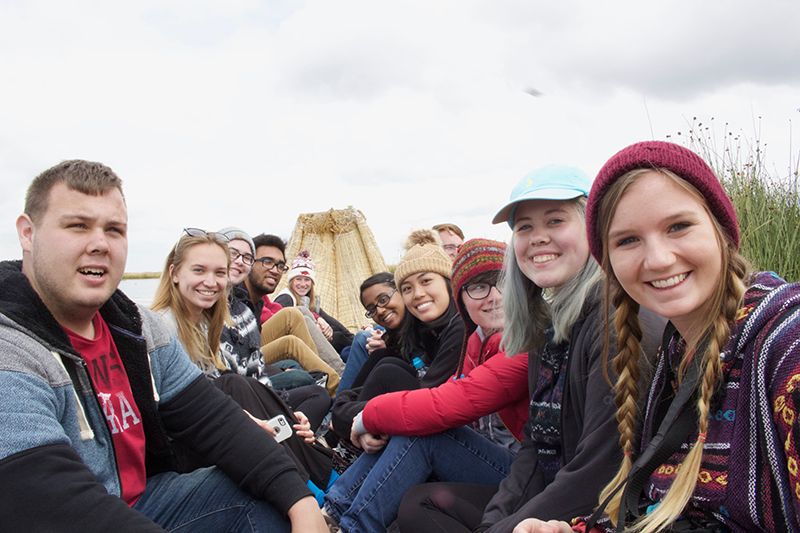
Honors Passport students board a reed boat for a tour of Lake Titicaca, the world’s highest navigable lake. Photo by Kendall Curlee.
With bright textiles and chicha morada in abundance, the Honors Passport: Peru intersession course was a whirlwind of cultural riches. Don’t think that means that it was lacking in rigor. Dr. Laurence Hare, who led the course along with Dr. Shawn Austin, reports on the hefty reading load, on-site presentations and journal entries that were taking place behind the scenes.
During two weeks traversing southern Peru for the Honors Passport course, we have enjoyed some truly memorable experiences. From seeing a spectacular water show in Lima to rowing across Lake Titicaca in reed boats to climbing the terraces of the famed Machu Picchu, our students have had lots of fun. You can see it in the smiles that grace snapshots posted to Facebook and Instagram and in the clever posts in the Honors blog. I confess that I, too, have taken more than one selfie of my sunburned, yet still beaming visage as a way to capture these special moments.
In fact, we have had so much fun along the way that we tend to diminish the tremendous amount of work that students have put into this course. Cultural experiences matter a great deal, of course, but I see Honors Passport first and foremost as an academic experience meant to challenge some particularly high-ability students. It is an extension of three semesters worth of investigation into world art, architecture, history, and literature. Don’t let the casual smiles of our selfies fool you. This course is rigorous.
Students have been asked to draw upon the Peruvian example to answer two important humanities questions. The first deals with how hybrid cultural expressions in the arts (such as in painting, architecture, or literature) inform relationships of power in diverse societies. The second, which connects closely to my own research as a historian, asks about the relationship between heritage and identity. To approach these questions, our students had to do a lot of reading. We asked them to read nearly 175 pages of mostly primary sources and nearly a dozen articles treating theories of hybridity, reflections on art history and archaeology, and discussions of the politics of tourism. Each day, students respond to questions about the readings in a graded journal.
Moreover, each student chose one site along our journey, conducted in-depth research into the latest scholarship on their topic, and then offered a fifteen-minute oral presentation to their peers on site and a lengthy research paper at the end of the trip. This means that after long days of site visits, students spent their evenings hitting the books and crafting their reflections.
My colleague, Dr. Shawn Austin, and I are delighted that students have enjoyed their study abroad experience. But we also hope that they will take away both memories of good times and new skills and perspectives that will stay with them throughout their future careers. And we hope that they might look back on their academic accomplishments and remember that the learning was fun, too.

